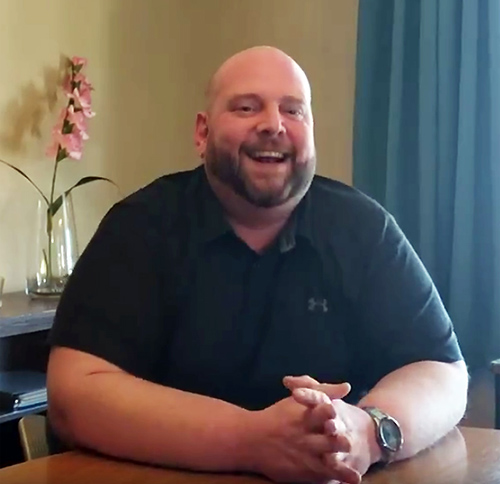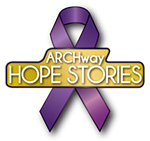Eric Gentry
Stories of Hope
ARCHway believes in recovery from the disease of addiction.
Sharing his Journey of Recovery
Interviewed by Emily Jung
As Eric Gentry was interviewed, anyone observing could see the heartache that he has endured as well as the triumph he has felt throughout his recovery, leading him to the life he enjoys today. His tone and mannerisms changed drastically from the beginning to the end. At first, he seemed nervous and uptight. His voice was low and sounded defeated almost as if he had reverted back to the codependent boy he once was. By the end of the interview, he was full of life and energy.
One could truly see his passion for helping others struggling through the disease of addiction. Codependency was a common theme in Eric’s story. Characteristics of codependency include the need to take care of others, putting others needs before your own, looking to others to validate your worth, and as a result, perceiving oneself as superior and self-righteous. Often times, it is said that the codependent is just as sick as the addict.
 His Story
His Story
Eric was raised by his mom and grandmother in Englewood, New Jersey, which was where his codependency began. His mother was diagnosed with breast cancer, forcing him to begin taking care of her at a very young age, including doing her hair and makeup when she was too weak to do it herself.
He spent much of his childhood going to hospitals and doctors. He was pulled out of school for months at a time as they searched for non-conventional cancer treatments. She passed away when Eric was only 14, leaving behind both a second mortgage taken out to help pay for her treatment, and resentment: “Why did this happen to her? Why did this happen to me?”
During all this, Eric also struggled with insecurities and anxieties about his weight, sexual orientation and performance in school, among other things. This began with his father, who had multiple children outside his relationship with his mother, and who was never present in Eric’s life. This left Eric feeling inadequate and unworthy. These feelings were perpetuated further by his mother’s boyfriend, who was verbally and physically abusive.
After his mom passed, it was just him and his grandmother. They moved to St. Louis to be closer to family, which tore him away from a school he knew, from friends he felt comfortable with, and pushed him into a family that again made him feel judged and less than worthy. Also typical, as codependents seek approval and attention from the loved ones they are helping, they often begin to feel like nothing they do is ever good enough.
This level of inadequacy was combated with the feeling of power and control he got from using and later selling drugs. “The abusee now becomes the abuser, and now I had the power…it was very seductive. I always had money. I always had drugs. And everybody there knew who I was and needed me,” Eric explains. Drugs gave him his power back after feeling so powerless for so long. Drugs allowed him to not feel insecure in his own skin.
He was now the center of attention, the one to whom everyone went.
Readers: you can see how this might make someone who was always wanting to please others feel on top of the world. But eventually Eric’s world came crashing down.
By the time he was 30, he was living with his grandmother and being paid as her home health aide. Between this income and his grandmother’s social security, he was able to go back to school for graphic design. He could have had a graphic design job in Chicago, but his grandma wouldn’t move. So he felt that he had to put his life on hold for her. Resentment continued to build. He eventually quit school to take care of his grandmother who, ultimately, passed away.
Eric explains that this was his rock bottom. “I had no purpose. I had no hope. Everything I had in my life was gone. I lost my house. I was about to lose my car.”
Weak, alone and heartbroken, he planned on using until he killed himself, a common thread in many stories of addiction. The feelings of unworthiness, hopelessness and fear had crept in and become, what seemed like, a point of no return. And that is when fate ultimately stepped in and he was arrested.
It was in jail that he had that sobering moment, where he realized he couldn’t keep living like this and there was no one else to blame but himself. He had to change.
It wasn’t immediate though. He had very few resources and no place to go.
It was a chain of events that led him to where he is today as a manager at Recovery House, transitional living in the St. Louis area, and as a certified peer specialist for the EPICC (Engaging Patients in Care Coordination) program. These events included bouts of sobriety, starting with sleeping, rent free, on a friend’s futon in her 9-year old son’s room, to sharing a basement with another friend in recovery. It included relapses where he slept on the floor of traphouses and hid behind bushes in Carondollete Park (St. Louis) to avoid the cops.
It wasn’t until he got to Recovery House where all the pieces of the puzzle were brought together in one room of hope; where he turned his control over to the right people: people who knew what he needed, where he needed to go, and how he could get there.
He explains in his interview the process of sitting down in front of John, the previous director of Recovery House, and others on that first day while they whispered about his future. The ARCHway Institute funded his first two months in transitional living at Recovery House until he was able to get into Bridgeway/Preferred Family, a medically assisted treatment facility. He received a grant through the Prescription Drug and Opioid Addiction program (PDOA). He was put on Vivitrol and prescribed the right psychiatric medications to help with his previously diagnosed psychological disorders.
It takes a village! And what happens when all these organizations work together? They have the power to create miracles, to change lives, to inspire and bring hope to all those struggling with the effects of addiction.
The organizations, medications and grants were just part of that recovery though. Transitional living took him away from active users. It focused on recovery and healing from the many issues that led to his addiction instead of simply focusing on sobriety as many transitional living centers do.
 The real heart of Recovery House, though, comes through the support of the men who live in the house and the peer specialists that are with them every step of the way. It comes from their 10 o’clock meetings that cut straight to the heart of the issues and barriers they are facing. It shines through the managers who have dedicated their lives to helping those in recovery.
The real heart of Recovery House, though, comes through the support of the men who live in the house and the peer specialists that are with them every step of the way. It comes from their 10 o’clock meetings that cut straight to the heart of the issues and barriers they are facing. It shines through the managers who have dedicated their lives to helping those in recovery.
Eric explains that you just can’t put into words the feeling you get from being part of this organization. He says you see how someone, who comes into the house having just overdosed, progresses to managing one of the houses and who then later works for the treatment center that saved their life in the first place! Eric is a clear example of this possibility. Eric ended with this comment:
“You can’t put a price on that. You can’t wrap it up, you can’t box it, you can’t sell it. There are many people who try to recreate it, and it’s just never going to happen. There is nothing like what we have right here.”
For more information about ARCHway Institute for Addictive Disease and Co-Existing Mental Health Disorders, contact:
ARCHway Institute for Addictive Diseases and Co-existing Mental Health Disorders
3941 Tamiami Trail Suite 3157-53, Punta Gorda, Florida 33950
Email: Emily.Jung@TheARCHwayInstitute.org
Phone: 314-635-8887
Website: https://TheArchwayInstitute.org/
Facebook: https://www.Facebook.com/TheArchwayinstitute/
Vimeo VOD: https://Vimeo.com/ondemand/archwaystoriesofhope

